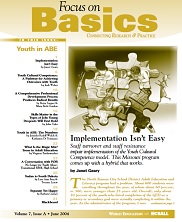In this issue of Focus on Basics, we explore the challenge of serving youth well without sacrificing the quality of service to older students.
Our cover story and the two that follow it form a trilogy: the journey from theory, through professional development, to practice. Missouri literacy program director Janet Geary and a colleague participated in what might be described as a “Cadillac” of professional development programs when they learned an approach to educating youth called Youth Cultural Competence. Janet writes candidly about the trials of implementation from her perspective as a program director. The changes her GED program made have resulted in increased retention and positive outcomes. Are they running a program that could be identified as a youth cultural competence program? Perhaps.
To find out, read Josh Weber’s article, page 6, on Youth Cultural Competence (YCC). YCC draws on what is known about youth development and has three main components: youth involvement, positive peer influence, and youth popular culture. He traveled to Missouri a number of times to provide training and support to Geary and colleagues from seven other programs in the Kansas City area, in a professional development process described by Betsy Topper and Mary Beth Gordon of the Metropolitan Alliance for Adult Learning in the article that starts on page 10.
Young dropouts need to improve their basic skills because skills matter to their economic futures, writes NCSALL researcher John Tyler, in the article that begins on page 16. Jennifer Roloff Welch and Kathrynn Di Tommaso examine how many youth are in the ABE system and why. It’s a substantial number and may well grow over the next few years. Oregon’s Virginia Tardaewether sees no reason to separate younger and older students. What better place to learn to live together, she suggests, than in the ABE classroom? (See page 22.) Students of all ages mix successfully in a high school for beginning English for speakers of other languages in Fairfax, Virginia. Originally established for young immigrants, explains principal Shelley Gutstein, the program now enrolls students of all ages. More about this model on page 23.
In South Dakota, Lara Ann Frey and Yvonne Lerew found it necessary to create a special class for young immigrants who had age-specific psychosocial needs as well as language learning needs. They describe the course they created in the article that starts on page 26. A community college in New Mexico also found that separating students by age works for them. Teachers Lilia-Rosa Salmon and Anastasia Cotton find that both the younger and older students now feel freer to address age-specific concerns within their classrooms and their academics have benefited as well.
These stories show us that there is no one way to serve youth well. Some programs separate them, to the satisfaction of both groups. Others keep them together. What does seem to appeal to both age groups is class-based instruction, and space to address personal as well as academic concerns. World Education, 2004.


